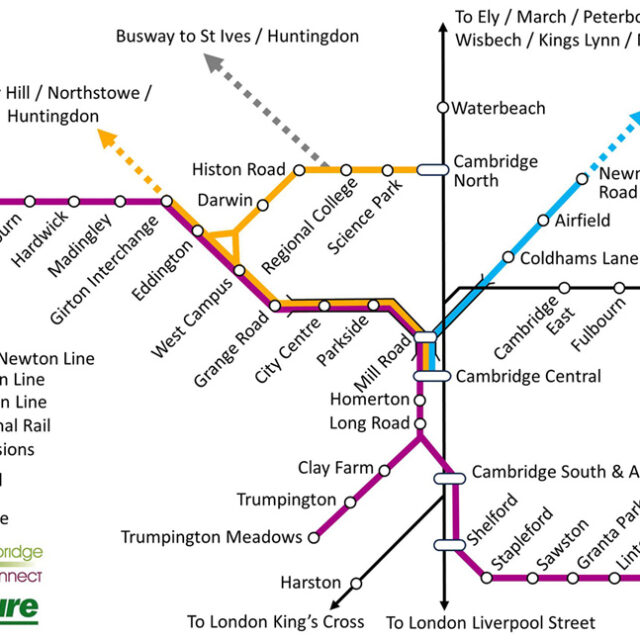Cambridge Connect and Railfuture East Anglia collaborated closely over 2020 / 2021 to make a radical update to the original Cambridge Light Rail proposals, first advanced in 2016. We have worked with a range of partners to develop this new vision, including Amey, Ankura, CMS, UK Tram and individuals who were responsible for delivery of the Docklands Light Railway and major extensions to Manchester Metrolink, as well as local residents with detailed knowledge of Cambridge and its surrounding region. Our focus has been on cost-effectiveness, practical deliverability, and reduction of risk. To …
Main Content
Let’s connect…
Cambridge is at a pivotal moment in its history.
Cambridge is experiencing rapid economic expansion and population growth. As a result, Cambridge is facing some of its greatest challenges. The need for more housing and effective transport links is pressing. The outstanding heritage, environment and quality of life in Cambridgeis under pressure. Given the scale of this challenge, it is vital that solutions developed today are fit for purpose when operational. Short-term projects – much as they are needed – should not compromise, or close off, options needed in the near future.
Barriers to connectivity detract from our quality of life, stifle opportunities, impede economic growth, harm the environment, and cause unnecessary waste. These barriers will increase without major commitments to, and investment in, solutions that are right for the scale of the problem. Piece-meal, local solutions will at best fail to meet needs, and at worst cause irreparable damage to the values of Cambridge. We believe a step-change in thinking is needed to meet the unprecedented scale of the challenge Cambridge is facing.
Cambridge Connect has collaborated with a wide range of organisations, companies and individuals - including Railfuture, UK Tram, Amey, Ankura, CMS, TXM Consult, 5th Studio and experts involved in CrossRail, Manchester Metrolink, Midlands Metro, Edinburgh Trams and the Docklands Light Railway, to create a detailed proposal for Cambridge Light Rail.
Recently we made major revisions to our proposals, with a keen focus on practical delivery and reduction of costs. We re-examined every aspect of the scheme to identify opportunities for efficiencies when meeting priority needs. The latest model comprises three light rail lines (Isaac Newton Line, Darwin Line and Eastern Line) serving Cambridge and the surrounding region, extending ~40 km. A short tunnel in the historic city core links the lines together. Delivery would be in three main phases, with the first two taking between 5-10 years. The overall cost of £1.4 bn includes the tunnel and underground stations, and would be spread over the delivery phases, making the scheme affordable. The phasing is flexible, and subject to more detailed discussion and stakeholder priorities.
Light Rail is a practical and important potential solution adopted in hundreds of cities world-wide. Light Rail offers the speed, capacity, frequency, reliability, convenience and accessibility to bring about major improvements to the Cambridge transport network. Light Rail is also highly scalable to meet future demand. It is the technology most likely to enable substantial change in people’s journey decisions, needed to create a more sustainable City. While more expensive than busways to build, light rail is more economical to operate and would provide an integrated and enduring solution.
In 2018 the Cambridge Mass Transit study concluded light rail was the best available technical solution and that the network model put forward by Cambridge Connect was the best practical solution. However, the study put forward a 'cheaper' solution using a rubber-tyred articulated bus called the "CAM" or "Cambridgeshire Autonomous Metro". The Strategic Outline Business Case showed, however, that the cost of CAM would be as much as light rail. Given its highly risky, bespoke and uncertain nature the costs of CAM would probably have exceeded light rail. The proponent of CAM, consultant Steer, put forward an almost identical proposal some 20 years earlier,which also failed to gain traction.
We welcome far-sighted approaches to an integrated and sustainable transport strategy for the Cambridge region. We support proven, low risk, deliverable solutions for a truly transformative transport system for Cambridge. Light rail is currently the only practical and proven technology with the capacity to deliver modal shift on the required scale.
When CAM was scrapped we welcomed that decision. However, the need for mass transit and network integration remains. Filling Cambridge with hundreds of buses per hour is not the answer. Our vision is for a city where there is far greater use of public transport, more pedestrianisation, walking and cycling, enabled and enhanced by light rail. There are many examples throughout Europe where this has been achieved, and it is time for Cambridge to raise its game. The recent government publication "The Case for Cambridge" highlighted the example of Freiburg as a light rail success story.
Cambridge Connect provides a new plan for the Cambridge Light Rail network. The first priorities we call the 'Isaac Newton Line' and the 'Darwin Line', which focus on the axes from the West Campus to the Cambridge Biomedical Campus and Addenbrookes via the city core and Cambridge Central Rail Station, on the northern arc to include the Science Park and Cambridge North Station, and the link to Cambridge East where Marshall's Airfield will soon be transformed into new housing and commercial development.
Newsfeed
New video profiling Cambridge Connect
Cambridge Connect is proud to announce our new video profiling our Cambridge Light Rail scheme. The video was made possible through a very generous …Read MorePhase One: an Open letter to all Cambridgeshire Councillors
On 16 March 2023 we sent an open letter to all Councillors on the Cambridgeshire County Council, South Cambridgeshire District Council and the Cambridge City …Read MoreLocal Transport & Connectivity Plan
Cambridge Connect made a supplementary submission to the Cambridgeshire & Peterborough Combined Authority public consultation on their new Local Transport and Connectivity Plan, the final …Read More
Isaac Newton & Darwin Lines – Phases 1 & 2
The Isaac Newton Line The Isaac Newton Line is a bi-directional Light Rail line extending from Cambourne in the west to Haverhill in the southeast, which would be delivered in three Phases. Phase One would be ~13 km in length, extending from the Eddington to Addenbrookes / Trumpington, via the University West Campus, Grange Road, City Centre, and Cambridge Central Rail Station. A tunnel within the historic City core would extend 4 km from a west portal in the Grange Road area to an east portal near Coldhams Lane, with a central portal near Cambridge Central Rail Station. The Isaac Newton Line …
Read more... about Isaac Newton & Darwin Lines – Phases 1 & 2
Light Rail Accessibility
Greenprint for a sustainable City. The accessibility of Cambridge Light Rail stops to residential / commercial areas in Cambridge is illustrated by the adjacent map. The percentage area of the city that is accessible on foot and by cycle to Light Rail stops is summarised in the table below. The map shows an accessible and attractive public transport alternative that would be transformative for inner city traffic, as more people decide to walk or cycle to their nearest stop and, instead of driving their car, take Cambridge Light Rail to their destination of choice. We believe this is a …

Cambridge Light Rail integrated strategy
Transport solutions need to be multimodal and well-integrated to be most successful (see, for example, the multimodal integrated approach in Nice and in Nottingham). While Cambridge Connect places emphasis on Light Rail as an important element to be considered in the mix, this needs to be connected to different modes of transport that are suited to different needs. It is also important to recognise that private vehicles are likely to remain a dominant choice for many for a long time to come. While this probably won't include space shuttles, other forms of transport that form part of the …
Benefits: speed & time
Cambridge Light Rail would provide people with short journey times on a rapid transit system. Based on an average speed of 33 kph (London Tube, Transport for London) including stops the proposed routes could move people across Cambridge astonishingly quickly. (A faster average speed of 60 kph has been used where the light rail line goes through rural areas). Journey times Cambridge Connect has calculated typical journey times between example stops if all options for the Cambridge Light Rail line were implemented. For example: Cambridge Central Station to Market Square: 4 mins! …
Fun Facts
Minutes
from Cambridge Central Station to Market Square on Cambridge Light Rail underground
Number of vehicles entering/leaving
Cambridge - per day - in 2015
maybe not such fun!
The year the first traffic lights were installed in Cambridge








